Honor Award
Hope Municipal Airport Intervention
Marin Braco, Student ASLA and Andrew Murphy, Student ASLA, Graduate, SUNY College of Environmental Science and Forestry
Faculty Advisor: Martin Hogue
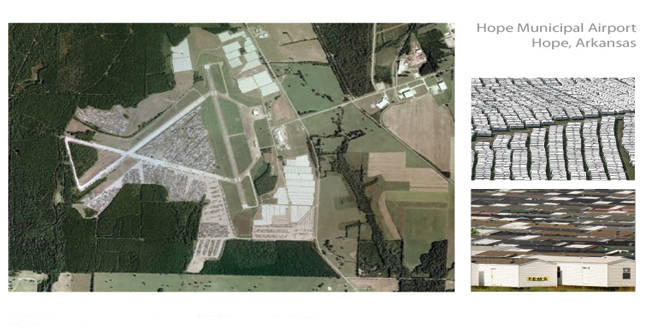 Close Me!
Close Me!Hope Municipal Airport is located 6 miles Northwest of Hope, Arkansas, a town of approximately 10,000 people. Originally established as a military airport during World War II, it was one of the largest of its king. More recently, it has housed 15,000 relief trailers manufactured for the Federal Emergency Management Agency (FEMA) in the aftermath of Hurricane Katrina.
Download Hi-Res ImageImage: Marin Braco and Andrew Murphy
Image 1 of 10
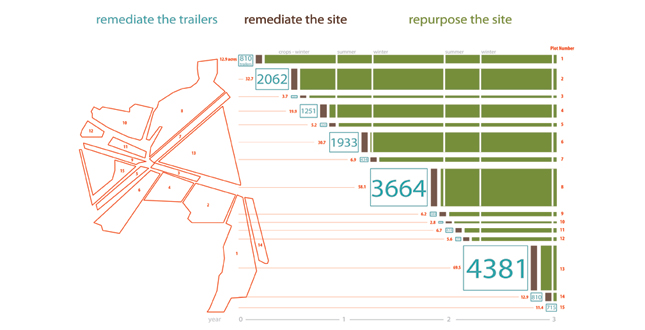 Close Me!
Close Me!Remediate the Trailers — Remediate the Site — Repurpose the Site
Download Hi-Res ImageImage: Marin Braco and Andrew Murphy
Image 2 of 10
 Close Me!
Close Me!Sequencing. Offsite Choreography. Of the 18000 trailers, 15000 will be phased offsite to more suitable storage locations. This diagram illustrates the geography and sequence of the move over 9 weeks.
Download Hi-Res ImageImage: Marin Braco and Andrew Murphy
Image 3 of 10
 Close Me!
Close Me!Dissipation: the Movement of Formaldehyde
Download Hi-Res ImageImage: Marin Braco and Andrew Murphy
Image 4 of 10
 Close Me!
Close Me!Remediate the Trailers — A two-person team, working together 8 hours a day for 3 days, will render 1 trailer fit for comfortable habitation, trailer remediation consists of 5 basic steps: 1-remove tainted fabrics and upholstery. 2-install preassembled ventilation system in roof. 3-sand and prep surfaces scheduled for lamination. 4-laminate composite-wood furniture with epoxy-powder (CH2O-free). 5-seal all joints to trap CH2O-emitting insulation.
Download Hi-Res ImageImage: Marin Braco and Andrew Murphy
Image 5 of 10
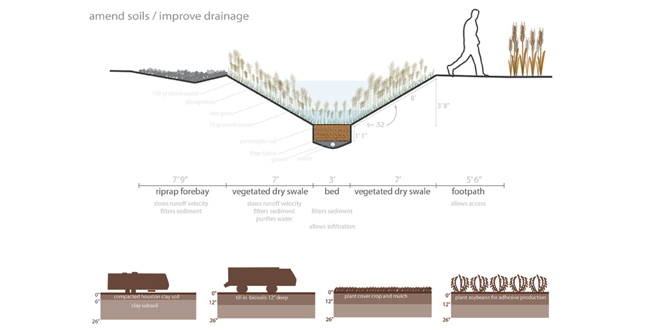 Close Me!
Close Me!Remediate the Site. Amend soils / improve drainage.
Download Hi-Res ImageImage: Marin Braco and Andrew Murphy
Image 6 of 10
 Close Me!
Close Me!Repurpose the site. Plant crops + produce wheat and sunflower board. The crop rotation will be a 6-crop, 3-year cycle. Both winter and summer crop productions have been calculated for 1 year in the cycle.
Download Hi-Res ImageImage: Marin Braco and Andrew Murphy
Image 7 of 10
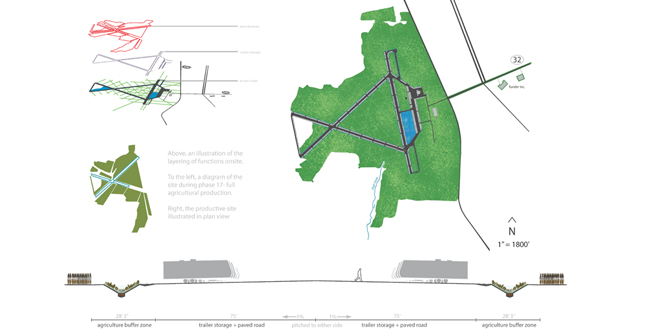 Close Me!
Close Me!The Site. Above, an illustration of the layering of functions onsite. To the left, a diagram of the site during phase 17-full agricultural production. Right, the productive site illustrated in plan view.
Download Hi-Res ImageImage: Marin Braco and Andrew Murphy
Image 8 of 10
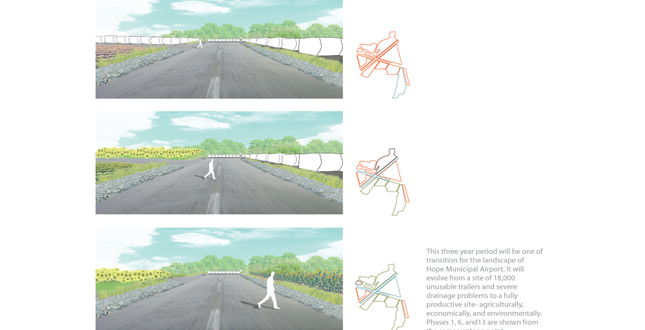 Close Me!
Close Me!This three year period will be one of transition for the landscape of Hope Municipal Airport. It will evolve from a site of 18,000 unusable trailers and severe drainage problems to a fully productive site-agriculturally, economically, and environmentally. Phase 1, 6, and 13 are shown from the same vantage point.
Download Hi-Res ImageImage: Marin Braco and Andrew Murphy
Image 9 of 10
 Close Me!
Close Me!3,000 trailers will remain on site for future emergency relief. They will be placed on both sides of the runway so that they are easily accessed but will no longer cause damage to the soil and drainage of this landscape.
Download Hi-Res ImageImage: Marin Braco and Andrew Murphy
Image 10 of 10
Project Statement
Hope Municipal Airport is located 6 miles Northwest of Hope, Arkansas, a town of approximately 10, 000 people. Originally established as a military airport during World War II, it was one of the largest of its kind. More recently, it has housed 15,000 relief trailers manufactured for the Federal Emergency Management Agency (FEMA) in the aftermath of Hurricane Katrina.
FEMA spent $2.7 billion to buy 145,000 mobile homes and trailers in the aftermath of the 2005 hurricane season to assist in disaster-stricken areas. Many of the 90,000 units rushed out to New Orleans and the Gulf Coast were built to extremely poor standards. In addition to leaky construction, it was later determined that the wood and glue specified in their design released harmful levels of formaldehyde gas that have caused serious respiratory troubles. Many of these units were later deemed unfit for human occupation, causing important stockpiles of unusable trailers.
Clearly visible from Google Earth, the blue tint of the Hope stockpile is an enduring and embarrassing reminder of Katrina and of FEMA’s poor management of this particular crisis. Parked on the airport’s linear runways for nearly 5 years, the leaky trailers have released harmful contaminants into the ground and have caused flooding in nearby properties.
Project Narrative
—2011 Student Awards Jury
Our intervention at Hope Municipal Airport will be an interweaving of three phases: remediation of the trailers, remediation of the site, and repurposing the site. The trailers currently contain toxic levels of formaldehyde because they were produced quickly and cheaply in the wake of Hurricane Katrina. To remediate the trailers we will utilize laminates on the particle board that prevent emission along with ventilation systems. The trailers will then be removed from the site, with the exception of 3,000 left for future disaster relief. To remediate the site we must address the high level of compaction on the soils left by the trailers. For this we will till biosolids into the ground at a depth of 12". This will be followed by a mulching and seeding to prevent erosion and further the nutrient cycling of the soil. This will prepare the soil for future agricultural purposes, to create formaldehyde free products.
Based on the logic of the site, and our ambition to solve the larger problem of formaldehyde we choose to repurpose the airport for creating alternatives solutions to particle board. The site not only has ideal soils and climatic conditions for the growth of the agricultural products necessary for alternative particle board, but there is also a particle board manufacturer, less than one mile east of the airport. This can easily be converted to produce alternative particle board, while the hangar on the airport grounds can be retro-fitted to accommodate a processing plant for formaldehyde-free adhesives.
One well-researched alternative adhesive is made of soybean resin. Almost all of the manufacturers that made these formaldehyde free board were taking other measures to promote health, both for humans and the environment. Instead of using wood chips which requires continually cutting down trees, they used more easily renewable resources such as wheat and sunflowers. We wanted to follow this approach in our own design. To help us organize the plantings of these crops and to approach this in the most sustainable way, we looked at rotational systems. We added three other crops to promote nutrient cycling, erosion control, and soil structure. This significantly reduces the need for fertilizers, pesticides, while also making this a more economically stable enterprise by diversifying our products. This 6-crop, 3-year cycle will begin one parcel at a time, as soon as soil is remediated and it is the proper time to plant.
Additional Project Credits
Martin Hogue and graduate assistant Charles Hamilton, Associate ASLA for their criticism and encouragement through out the development of this project.
SUNY ESF Department of Landscape Architecture






